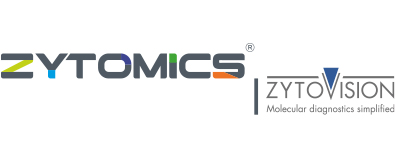Introduction
ZytoLight® system uses direct-labeled FISH probes, which eliminate the need to detect the probes with fluorophore-coupled antibodies. ZytoLight® products are designed for the identification of genetic aberrations e.g. translocations, deletions, amplifications, and chromosomal aneuploidies by Fluorescence in situ Hybridization (FISH) in formalin-fixed, paraffin-embedded (FFPE) tissue sections or cytology specimens.
Method Description & ZytoLight® Fluorochromes 
The ZytoLight® system uses direct-labeled FISH probes. The probes are detected by fluorescence microscopy using appropriate filter sets. Due to an exciter filter, full-spectrum light, emitted by the microscope lamp, is reduced to light of a defined wavelength that specifically excites the fluorophore of the probe. This light is reflected onto the specimen by a dichroic mirror. The fluorophore emits light of longer wavelengths that passes the mirror. Finally, a barrier filter reduces the emitted light to a defined wavelength that can be detected.
Two factors that mainly influence FISH analyses:
- Fluorochromes of the FISH probes
- Appropriate filter sets
Please refer to your local distributor for precise information regarding the suitable filter sets.
ZytoLight® Kits – Convenient Solutions
For making FISH analysis reliable and user-friendly, ZytoLight® FISH probes are intended to be used with the appropriate Implementation Kit (annotated in the individual probe's instruction for use):
- ZytoLight® FISH-Tissue Implementation Kit (Z-2028-5/-20) for FISH analyses on FFPE specimens
- ZytoLight® FISH-Cytology Implementation Kit (Z-2099-20) for FISH analyses on cytology specimens
Both Implementation Kits include all necessary pretreatment solutions, wash buffers and DAPI/DuraTect-solution and a detailed protocol to perform successful FISH experiments.


 PRODUCTS
PRODUCTS







